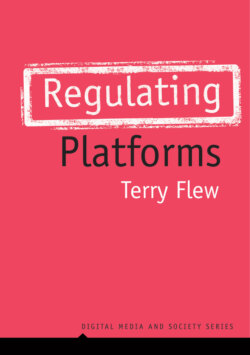Читать книгу Regulating Platforms - Terry Flew - Страница 26
Renewed Regulatory Activism
ОглавлениеFor much of the period in which digital platforms rose to dominance, public policy was being shaped by ideas that emphasized the limits of state agencies as effective regulators of corporate conduct. While reformers of the 1960s and 1970s pointed to market failure and the need for the kind of regulation that should restrain corporate self-interest and promote the public good, the policy pendulum in the 1980s, 1990s, and early part of the subsequent decade swung strongly towards deregulation, that is, towards setting limits to the power of governments over corporations and markets. Against the assumption that ‘the creation of regulatory agencies is … the concrete expression of democratic reform’ (Horwitz, 1989, p. 23), approaches such as public choice theory saw regulators as self-interested bureaucrats who seek to use the regulatory process in order to advance the interests of their own agencies (Christensen, 2011). A related concept was that of regulatory capture, whereby regulators came to identify their own interests with those of the industries they regulated, thus creating both policy barriers to new entrants and congnitive barriers to new approaches – that is, to the factors that would drive competition and structural change. A famous early example of capture theory was Ronald Coase’s critique of the FCC as coming to view the broadcasting industry through the perspective of the incumbent licensees, so that ‘regulation of the broadcasting industry by the Federal Communications Commission resembles a professional wrestling match. The grunts and groans resound throughout the land, but no permanent injury seems to result’ (Coase, 1966, p. 442).
Within policy and regulatory communities, the focus of regulation itself had moved away from traditional approaches and rationales. While market failure had traditionally been a driver of economic regulation, there was growing attention to regulatory failure and to the limitations of direct government regulation in increasingly complex environments. In particular, the view that regulators may lack expertise in the areas and fields that they were regulating, or that existing regulations may be inefficient, may fail to be cost-effective, or may have perverse behavioural consequences, gained greater currency (Baldwin et al., 2012; Freiberg, 2010).
One response was the growth in co-regulatory arrangements where industry bodies took primary responsibility for enforcing regulatory compliance; they were overseen by a government regulator subject to an approved industry code. Another response was what came to be known as responsive regulation. Pioneered by Ayres and Braithwaite (1992), responsive regulation proposed that regulatory strategies would in the first instance entail the use of incentives, education, and persuasion to achieve compliance; more coercive approaches would operate at the higher levels of the regulatory pyramid. The concept of responsive regulation also introduced tripartism, whereby public interest and advocacy groups would be directly engaged in the regulatory process, working with industry and regulatory agencies around agreed policy solutions (Drahos and Krygier, 2017).
The underlying assumptions behind responsive regulation was that by and large the corporate sector could be trusted by consumers and citizens to ‘do the right thing’, as it was in its collective interest to do so, and that a ‘light touch’ regulation was thus warranted; the problem was for the most part one of a few ‘bad apples’. In light of the global financial crisis (GFC) of 2007–8, this optimism about industry-driven regulation took a hammering. The GFC, which had a massive impact on all western economies throughout much of the 2010s, was attributed by many to a relaxing of financial regulations that had been going on in many countries for a number of years (Picciotto, 2011; Stiglitz, 2010). The problems with reducing the direct regulation of financial institutions and markets and relying more heavily on the industry’s self-regulation were reinforced through shared mental models (Denzau and North, 1994) of how financial markets work, so that by 2007 ‘the ideational structure had ... become [not] merely embedded but almost impervious to challenge’ (O’Brien and Gilligan, 2013, p. xxiv). Until the markets themselves failed to behave as the models predicted!
There is considerable evidence worldwide of a growth in regulators’ attention to the structure of markets in the digital economy and to the conduct of digital platform companies. This new regulatory activism first became apparent in the European Commission through adverse judgements on Apple’s and Google’s alleged anticompetitive practices and through the 2016 General Data Protection Regulation (GDPR), which outlined a principles-based framework for the handling of data within the European Union (Keen, 2018). But the impetus towards regulatory activism has accelerated since 2016, particularly in light of scandals such as those around Cambridge Analytica and populist concerns about the power of digital platforms. Indeed it has reached the point where key industry figures such as Facebook’s CEO concede, at least publicly, that ‘the real question, as the Internet becomes more important in people’s lives, is what is the right regulation, not whether there should be or not’ (Zuckerberg and the Senate Commerce, Science, and Transportation Committee, 2018).
